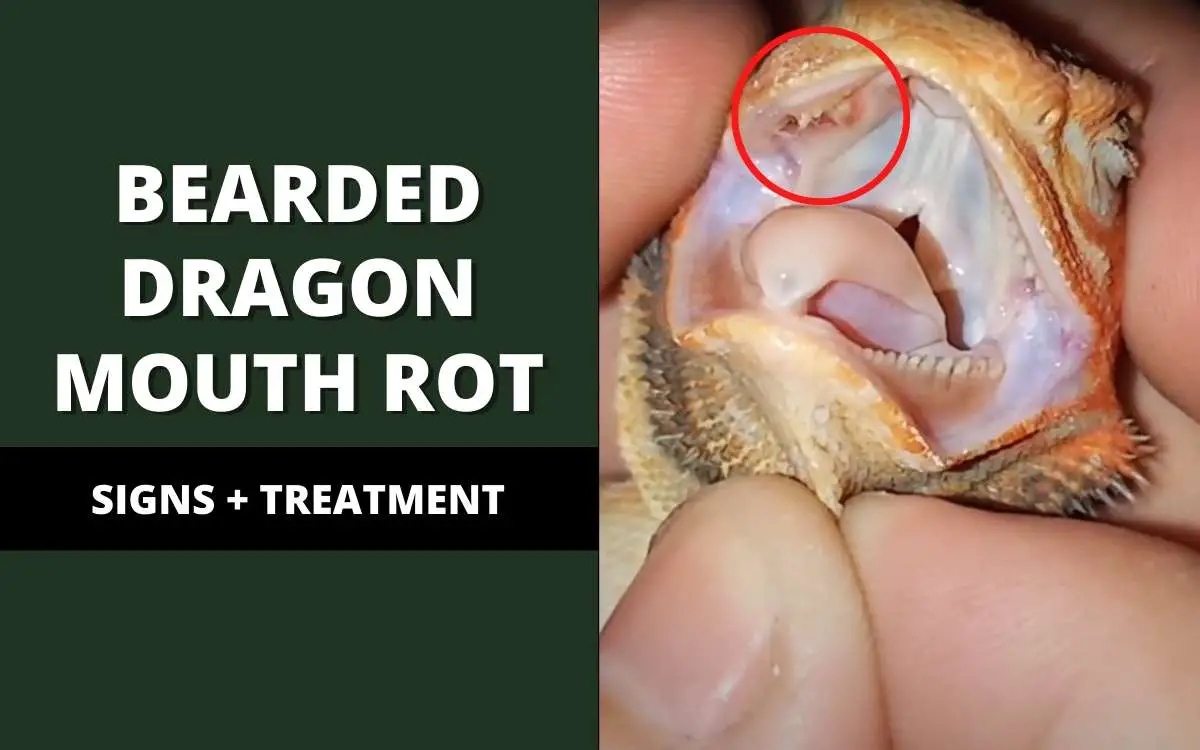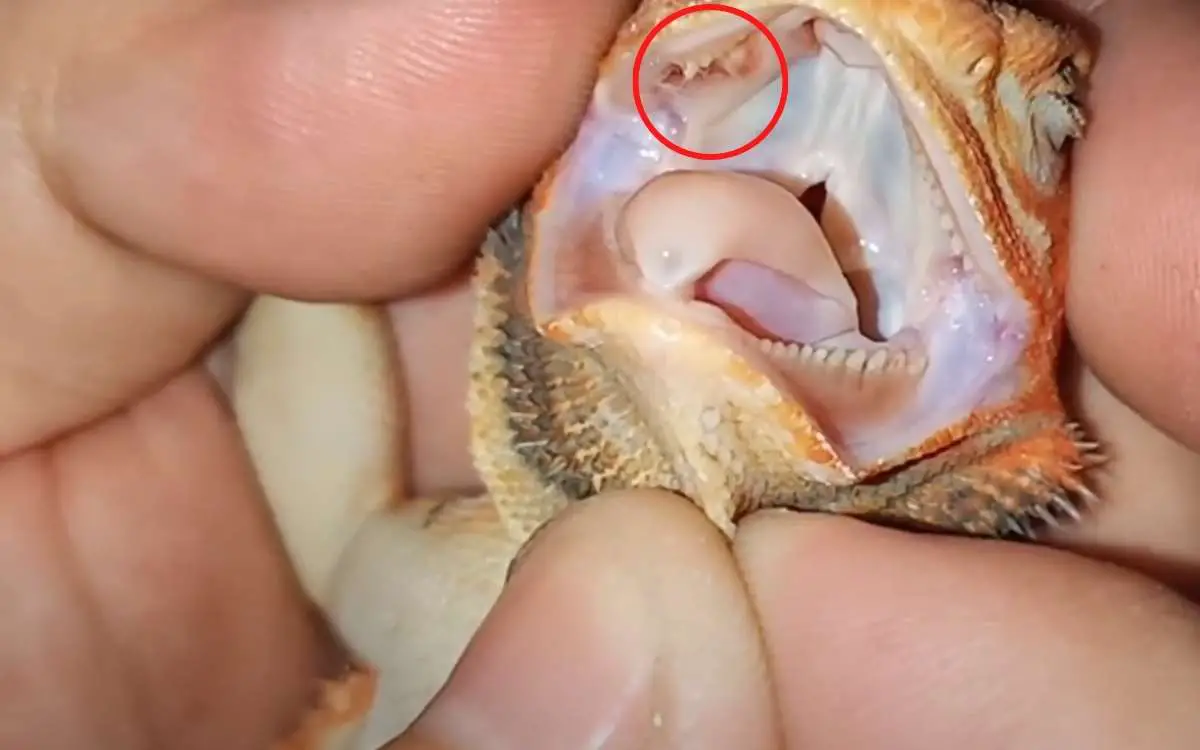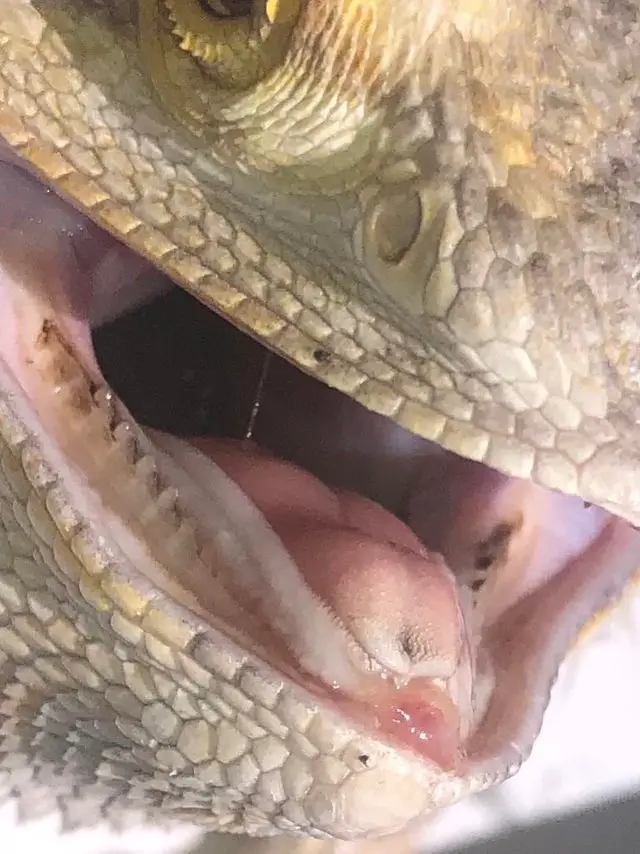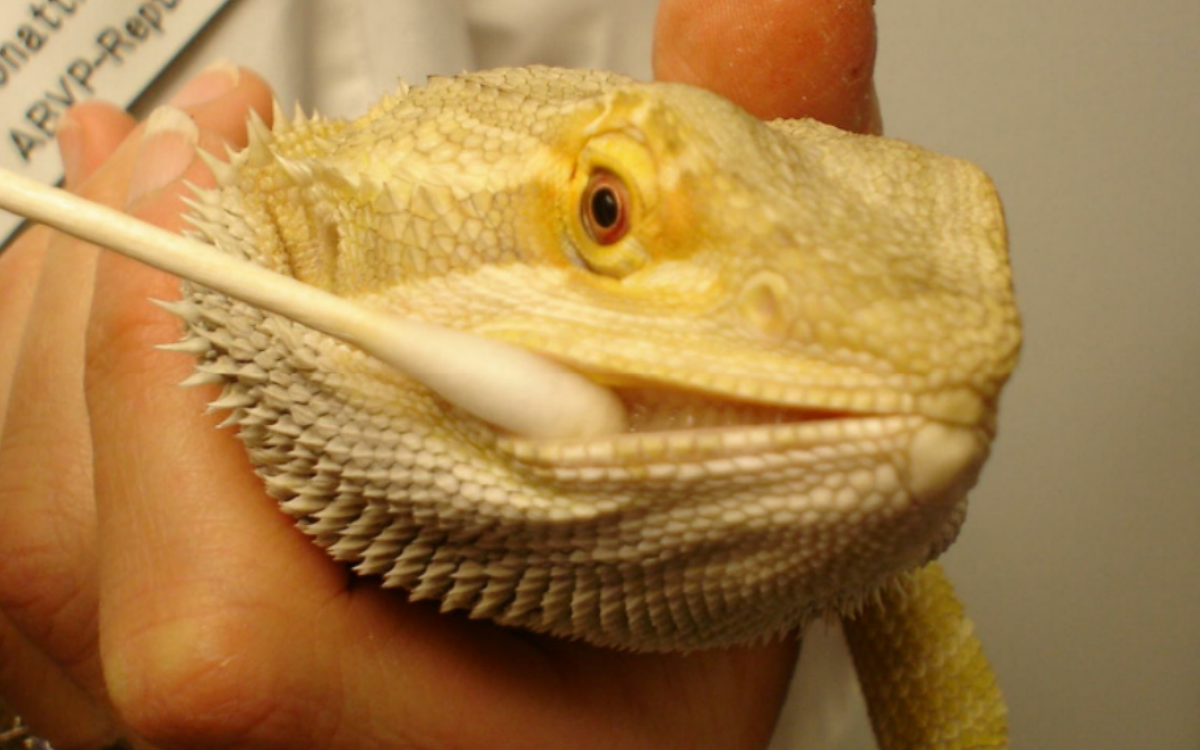Disclaimer: As an Amazon Associate I earn from qualifying purchases. Therefore, we may collect a share of sales from the links on this page, at no extra cost to you!

Bearded Dragon Mouth Rot? (5 Signs + Home Remedy!)
Bearded dragon mouth rot is a very unfortunate illness that can be difficult to detect but fortunately, quite easy to treat.
By the time you are finished reading this guide, you will know how to detect and treat mouth rot. Along with that, you will also know all about how you prevent your bearded dragon from ever contracting mouth rot.
But, before we begin, lets summarize what mouth rot is and how can you treat it at home:
Bearded dragon mouth rot (infectious stomatitis) is a common disease which can result in symptoms such as: A loss in appetite, patches on the oral cavity, bloating, loose teeth, and bleeding gums. Fortunately, mouth rot can be treated at home by taking an antiseptic called Betadine (povidone-iodine) and applying to the infected area with a cotton swab.
Now let’s dive a little deeper and learn how to identify, treat, and prevent mouth rot in this simple to follow guide!
Table of Contents
How Can You Tell if Your Bearded Dragon is Suffering from Mouth Rot?
Mouth rot comes with a few noticeable symptoms. All of these symptoms, if present, are a strong sign that your bearded dragon is suffering from mouth rot.

Patches on The Oral Cavity
The first symptom to look for is found on your bearded dragon’s oral cavity. Take a look at your bearded dragon’s oral cavity, and notice if there are patches of yellow-and-gray or white-and-gray. More often than not, these patches are rather small, but look closely and see if patches with those colors are present.
Assuming those patches are present, then that’s a sign your bearded dragon is suffering from mouth rot.
No Appetite
Sometimes, though, those patches are either not present, or very difficult to notice. Assuming that’s the case, there are several other symptoms you can look for. The more of these symptoms you notice, the greater the likelihood of mouth rot.
Anytime a bearded dragon is suffering from mouth rot, eating is difficult and unpleasant. Because of this, if you notice your bearded dragon is eating far less than normal, then they may be suffering from mouth rot.
Bloating
Even though a bearded dragon with mouth rot eats far less than usual, bloating is common. Anytime your bearded dragon is eating less, yet bloating up, that’s a strong sign your bearded dragon is suffering from mouth rot.
Loose Teeth/Broken Teeth
Two of the most extreme symptoms include your bearded dragon’s teeth loosening or falling out completely. Both of these symptoms are a strong sign of mouth rot. More than that, though, they’re a significant health risk and mean you need to take your bearded dragon to the vet immediately.
Bleeding Gums
Bleeding gums, as a symptom of mouth rot, is somewhat uncommon. But, that being said, it’s a noticeable symptom that often means your bearded dragon has been dealing with mouth rot for some time and is way past due for a visit to the vet.
What is the Cause of Mouth Rot?

A bearded dragon can contract mouth rot, as a disease, from a variety of sources. Mouth rot manifests itself in viral, bacterial, and fungal form. These variations of the disease can be found in many places. Determining the form of a mouth rot infection is often quite difficult and, in many cases, simply isn’t necessary.
No matter the exact source of a mouth rot infection, there’s a strong chance that the infection took place as a result of a weakened immune system. A weakened immune system is often caused by a series of different factors, all of which break down the natural defenses of your bearded dragon and make them far more susceptible to diseases.
The most common cause of a weakened bearded dragon immune system is stress. Stress erodes your bearded dragon’s natural defenses – much the same way stress lowers the natural defenses of human beings – making it easier for diseases to come in.
Stress is often the product of a stressful environment. A stressful environment is often the product of environmental conditions that go against your bearded dragon’s nature.
The most notable environmental conditions that can create a stressful environment are as follows: a temperature that’s too low or too high, a faulty basking lamp, an unhygienic enclosure, and a poor diet.
Within a stressful environment, your bearded dragon will experience great difficulties being comfortable. As a result, they will never be able to fully relax. Discomfort weakens the immune system and makes contracting mouth rot, along with other diseases, a very easy task.
How Can You Cure Mouth Rot?
Mouth rot is, primarily, cured with antibiotics. To obtain these antibiotics, you must take your bearded dragon to the vet. But, if you catch mouth rot early on, you can use a tried-and-true home remedy to eliminate the infection.
We also have an article discussing the various types of antibiotics you can administer right at home. These antibiotics are 100% tested, safe, and approved by veterinarians.
Although, the best antibiotic for treating mouth rot is called Nature Zone Rot Guard. You can purchase it on Amazon by clicking here.
Nature Zone Rot Guard is backed by thousands of users who have had reptiles that suffered from mouth rot. Best of all, it strengthens your bearded dragons immune system to prevent reinfection.
Application is simple; just add 1/4 tsp to 1 oz. of water and brew for 10-15 minutes. From there, you will stir it to form a paste. Thereafter, you will apply the paste directly to the infected area with a standard Q-Tip.
Mouth rot can be difficult to treat without antibiotics. If left untreated, your beardie could suffer from further infection or even death. Hence, why it’s so important to target the issue sooner than later.
The Home Remedy

Right before we dive in and describe this home remedy, there’s one thing you must know: this home remedy should only be used if mouth rot has just begun to set-in. As soon as the symptoms of mouth rot become more easily noticeable and pernicious, then this home remedy is no longer effective.
For you to make this home remedy, you can use an antiseptic or a disinfectant. The antiseptic this home remedy uses is Betadine. But, if you prefer to use a disinfectant, you must use Nolvasan. Both of these chemical solutions work very well and, generally speaking, produce the same results.
Take a small cup of the chemical solution you’ve chosen and pour it into a larger cup of water. Make sure this cup of water is no larger than a mug. Mix the chemical solution into the water until the solution is completely broken up.
As soon as that’s finished, the potency of the chemical solution will have been greatly diminished. This ensures that the chemical solution is unable to harm your bearded dragon.
Take a cotton swab and dip one end of the cotton swab into the mixture you’ve just created. Right after you do that, take the cotton swab and rub the wet end all across the infected spaces in your bearded dragon’s mouth. Make sure to do this gently, but thoroughly, so your bearded dragon is not uncomfortable during the process.
Once the infected spaces are covered in chemical solution, you will need to rinse those spaces off. Doing so with a gentle cloth and some water is the best approach. Make sure any remnants of the cleaning solution are completely removed. If you can, remove any loose bits of gunk or grime within your bearded dragon’s mouth.
Later in the day, repeat the process. Then, repeat the process two more times, the following day. The symptoms will begin to fade away soon after. But, if they don’t, then you will need to take your bearded dragon to the vet.
Taking Your Bearded Dragon to The Vet
The home remedy outlined in the previous section works very well. But, as a home remedy, it only works if your bearded dragon’s mouth rot symptoms are still in their early stages. Past those early stages, the home remedy is no longer effective, which means that you must take your bearded dragon to the vet.
To ensure that your bearded dragon’s health is dealt with in the best manner possible, try to find a vet that knows about bearded dragons and has experience with them. A vet who knows how to treat a bearded dragon will give your bearded dragon the best care possible, while making this process as easy as it can be.
Regardless of the current status of the mouth rot infection, your vet will most likely prescribe antibiotics. The purpose of these antibiotics is to eliminate the symptoms of mouth rot and to eliminate the infection.
Right before you leave the vet’s office, make sure you know how to give your bearded dragon this antibiotic. A set of simple and specific instructions is essential. That way, the antibiotic won’t be applied improperly.
What if it Isn’t Mouth Rot?
Sometimes, even if it looks like mouth rot – or some other illness – it really isn’t. Rather, the conditions your bearded dragon is dealing with may stem from another illness entirely or they may be a completely natural part of your bearded dragon’s living habits.
Before you do anything, you must make sure that the mouth rot symptoms you notice are, in fact, genuine symptoms of mouth rot.
Bearded Dragons Shed Regularly
A grown bearded dragon will, on average, shed anywhere from once-per-month to once-every-three-months. The exact frequency is heavily dependent on genetics. Shedding, and its symptoms, are natural and necessary.
The shedding process can take as little as three-days or as long as three-weeks. Throughout the process, there are a few symptoms that your bearded dragon may experience. A couple of these symptoms, in particular, are very similar to those that take place when your bearded dragon experiences mouth rot.
Many bearded dragons become lethargic during the shedding process. This lethargy is often accompanied by a complete lack of an appetite. Yet, despite this lack of an appetite, it is not uncommon for bearded dragons to puff up during the shedding process.
All three of those symptoms are common to shedding, as well as mouth rot. Since this is the case, take a good look at your bearded dragon’s mouth and skin before you assume that they are dealing with mouth rot. A mouth free of impurities is a strong sign of shedding. Loose, saggy skin is an even better sign.
Sometimes, though, you still may not be sure if your bearded dragon is shedding or dealing with mouth rot. In those cases, the best course of action is often to take your bearded dragon to the vet. There, you will get a definitive answer.
Brumation is Common
Many bearded dragons will go into brumation when the seasons change. Brumation is essentially hibernation but for bearded dragons. Just like hibernation, brumation is a response to seasonal changes that bring cooler air and greater humidity. Since this is the case, brumation is most common during the months in-between September and March.
Throughout your bearded dragon’s brumation period, your bearded dragon won’t eat. Rather, all your bearded dragon will do is sleep and relax for large portions of the day. And then, one day, after the brumation period is over, your bearded dragon will get up and begin resuming their normal routine.
A lack of an appetite, and lethargy, are both symptoms of mouth rot. But, brumation is not an illness of any sort and is, instead, a natural cycle that most bearded dragons go through.
Even though your bearded dragon won’t eat anything during brumation, that doesn’t mean they will become unhealthily thin. Rather, a bearded dragon will, before brumation, have large deposits of fat stored up, so that they do not need to consume any food. But, if your bearded dragon is brumating and becoming too thin, that’s a good sign that your bearded dragon is, in fact, sick.
How Can You Prevent Mouth Rot?
A bearded dragon’s environment is the main cause of illness. The reason for this is, as mentioned earlier in this guide, that a proper environment will create comfort, whereas an improper environment will create discomfort and stress. Discomfort and stress leads to a weaker immune system, which makes your bearded dragon more susceptible to illness.
To prevent bearded dragon mouth rot – or most other illnesses, for that matter – you must create a proper environment for your bearded dragon. Do this, and your bearded dragon will be healthy and happy.
Clean the Enclosure
Every bearded dragon needs a clean enclosure. A clean enclosure is comfortable, which will keep your bearded dragon healthy. Along with that, a clean enclosure is free of bacteria, germs, and parasites.
To keep your bearded dragon as healthy as possible, clean the enclosure every week. For you to do this, all you need is a soft sponge and a terrarium-safe detergent. Remove everything from within the enclosure, and thoroughly wipe the surfaces in the enclosure.
Right before you put your bearded dragon back into the enclosure, make sure the enclosure is dry. Bearded dragons are not meant to be in humid environments, and being in one is unhealthy.
Brush Their Teeth
Another thing you can do to prevent mouth rot is to cleaning your bearded dragons teeth regularly. You can learn how to do this by reading our simple guide and video on brushing your bearded dragons teeth.
To clean your beardies teeth, you’ll need a Q-tip or cotton swab, and a solution called Chlorhexidine. Simply use the Q-tip or cotton swab to gently open your bearded dragons mouth and perform a simple back-and-forth motion for a few seconds.
A Warm Space
Every bearded dragon needs a warm space they can relax in. To create this warm space, you need a good basking lamp that produces a nice, warm temperature.
A basking lamp should produce a temperature that is anywhere from 95-degrees Fahrenheit to 110-degrees Fahrenheit. For the periods in which your bearded dragon is healing from an illness, a temperature as high as 110-degrees is perfectly fine. But, when your bearded dragon is not healing, a slightly-lower temperature is often ideal.
Regardless of the exact temperature you choose, make sure the space under the lamp is warm and cozy. A warm and cozy space will keep your bearded dragon comfortable and healthy.
Final Thoughts
Mouth rot is a nasty and unfortunate illness that many bearded dragons will, at one point or another, be forced to deal with.
Even though mouth rot is so nasty it is, fortunately, rather easy to deal with. Catching it early means that you can use a simple home remedy to eliminate the infection. Catching it a little later means that your bearded dragon must take some antibiotics.
To prevent either of those, relatively easy, scenarios from taking place, make sure to keep your bearded dragon’s clean and comfortable. As long as your bearded dragon is comfortable, your bearded dragon will be healthy.
